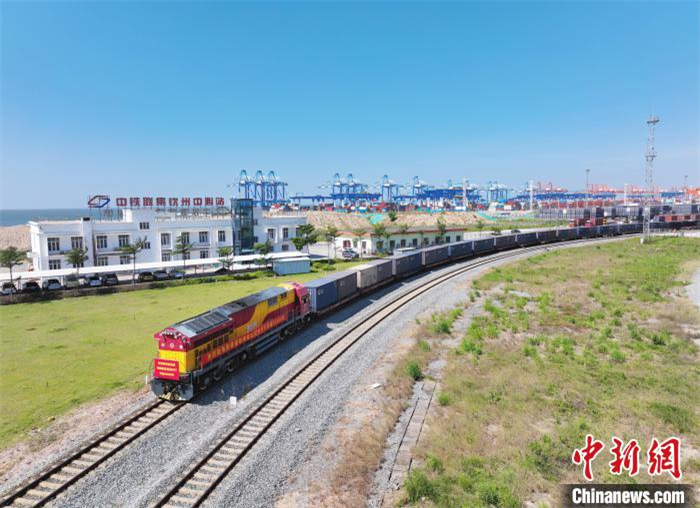China's rail-sea intermodal trains make 30,000 trips over past 6 years
A rail-sea intermodal freight train of the New International Land-Sea Trade Corridor departed from Qinzhou, south China's Guangxi Zhuang Autonomous Region on Oct. 8, carrying 110 containers of Indonesian ghee, Vietnamese sweet potato starch and Hainan coconut juice.
Bound for southwest China's Chongqing Municipality, the train made the 30,000th trip along the trade corridor since the service was launched in 2017. The New International Land-Sea Trade Corridor is a new channel of international trade jointly built by provincial-level regions in western China and ASEAN members.

A rail-sea intermodal train of the New International Land-Sea Trade Corridor departs from the Qinzhou railway container center station in Qinzhou, south China's Guangxi Zhuang Autonomous Region, Oct. 8. [Photo/Lao Guangwei]
According to Huang Jiangnan, head of the Qinzhou Port East Station, the station was once merely a supporting facility for the bonded port area in Qinzhou, containing only three tracks and staffed by just two people, and only one or two freight trains departed from the station each week.
The expansion of the New International Land-Sea Trade Corridor has transformed the Qinzhou Port East Station into a bustling international cargo hub. It now boasts 12 tracks and 43 employees, with approximately 20 land-sea intermodal trains arriving and departing on a daily basis.
Reliable data showed that the number of rail-sea intermodal trains on the trade corridor increased from 178 in 2017 to 8,820 in 2022, with an annual growth of more than 30 percent. The trains are expected to make more than 9,000 trips in 2023.
Driven by the China-proposed Belt and Road Initiative, rail-sea intermodal trains of the New International Land-Sea Trade Corridor have recorded a steadily growing number of trips.
Due to its proximity to ASEAN countries, Guangxi has become a key hub of the trade corridor.
More and more agricultural products from ASEAN and other countries, such as Cambodian rice, Thai coconuts and mangosteen, Vietnamese passion fruits and sticky rice, as well as Brazilian frozen beef, have entered the Chinese market through the trade corridor, said Li Hongfeng from Guangxi Beibu Gulf International Transport Development Co., Ltd.
Meanwhile, China's new energy products, new materials, and mechanical and electrical products are being shipped abroad through this kind of rail-sea intermodal transportation, Li added.
According to statistics, in 2022, the total foreign trade of provincial-level regions along the trade corridor through Guangxi's ports exceeded 500 billion yuan (about $68.54 billion), a record high. In the first half of 2023, total trade exceeded 290 billion yuan.
The trade corridor has basically formed three main routes in the east, middle and west, as well as three logistics modes - rail-sea intermodal transportation, international railroad intermodal transportation and road shuttle buses. It serves 69 cities in 18 provincial-level regions in China.
























